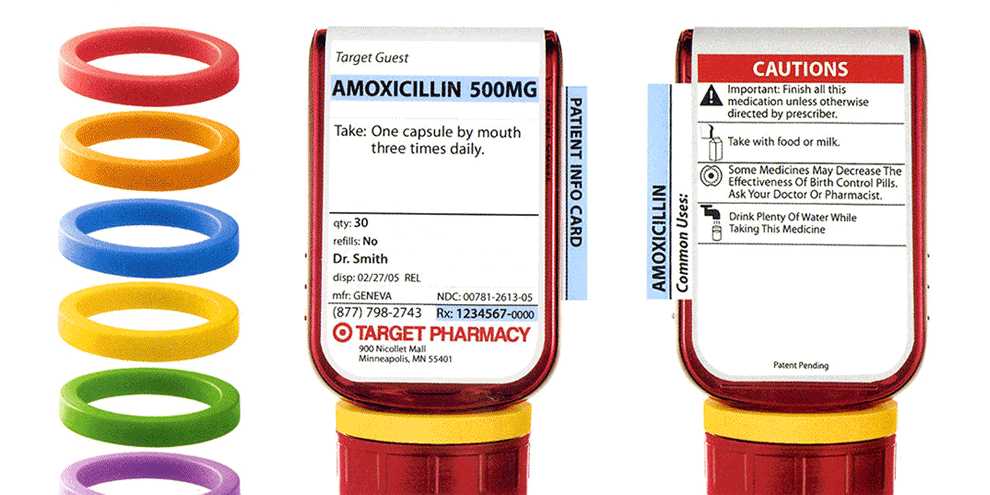Target innovates again
 Target has long touted its practice of using design to improve lives. Now it’s using design to possibly save them. The new Target-red ClearRx containers, which debuted May 1st, boast a host of user-friendly features aimed at making prescription medicine usage safer and easier. The palm-sized vials, which open on the bottom rather than the top, have a squarish shape which allows for flat fronts that place all the necessary information right where the patient needs it. Color-coded rings are available to identify and personalize each prescription. Detailed information on a drug (its common uses, side effects) now comes on a card that sits tucked behind the label. A separate, more extensive education sheet comes with three punched holes so it can be saved in a binder for reference.
Target has long touted its practice of using design to improve lives. Now it’s using design to possibly save them. The new Target-red ClearRx containers, which debuted May 1st, boast a host of user-friendly features aimed at making prescription medicine usage safer and easier. The palm-sized vials, which open on the bottom rather than the top, have a squarish shape which allows for flat fronts that place all the necessary information right where the patient needs it. Color-coded rings are available to identify and personalize each prescription. Detailed information on a drug (its common uses, side effects) now comes on a card that sits tucked behind the label. A separate, more extensive education sheet comes with three punched holes so it can be saved in a binder for reference.
The new bottles may not catch on with consumers and draw business away from the Walgreens of the world, but there’s no doubting the genius of taking a mundane yet vitally important item like a prescription bottle and reworking it into a brand differentiator.
Canadians support market research
Eighty-seven percent of Canadians believe that market and survey research serves a valuable societal purpose, but deceptive telemarketing practices by unscrupulous direct sellers and fundraisers remain a threat to the goodwill that Canadians have for survey research, according to a national poll by the Marketing Research and Intelligence Association (MRIA), a Canadian industry association.
“Canadians overwhelmingly maintain a high regard for survey research as a forum for providing input and feedback to corporate and government decision-makers,” says Don Mills, president of the MRIA. In fact, 87 percent of respondents in the MRIA survey agreed that research serves a valuable purpose by allowing them to voice their opinions on important issues related to products, services and public policy.
“Unfortunately, Canadians continue to be plagued by fraudulent marketers and fundraisers who use the survey research industry’s good reputation to sell goods or services or solicit money under the guise of a legitimate marketing research survey. Alarmingly, our study shows that more than half of Canadians continue to be subjected to deceptive direct selling and fundraising practices each year,” Mills says.
These practices, known in the industry as mugging (marketing under the guise of interviewing) and sugging (soliciting or selling under the guise of interviewing), are illegal in Canada. Yet, 53 percent of respondents reported being contacted for a survey that actually turned out to be an attempt to sell a product or service, while another 27 percent had received survey calls whose true purpose was to raise funds for a charity or similar organization. “Respondent rights are at the core of our industry, and the violation of respondents’ rights by those who pose as survey researchers under false pretenses is a serious issue,” says Mills. “MRIA has been working closely with Canadian legislators to address this issue, including operating the Canadian Survey Registration System to track our members’ research projects.”
Canadians continue to hold a very positive attitude towards the research industry. The study indicates that the participation rate in surveys significantly increased over previous years, indicating that respondents do not associate legitimate researchers with fraudulent practices. In 2004, 52 percent of Canadians had participated in a survey in the previous year, as compared to 45 percent in 2001 and 42 percent in 1995.
A dispatch from the media measurement front
An April New York Times Magazine article by Jon Gertner offered a thorough and thoughtful examination of the current state of media measurement, chronicling the efforts of Arbitron, Nielsen and little-known ErinMedia to create and perfect the next generation of technology to monitor what we watch, hear and read. It will be fascinating to see not only which system, if any, wins out but also to watch the impact that the numbers have on marketing and programming budgets. The article raises a number of questions: Will measuring viewership via cable TV set-top box trump the People Meter approach? Will out-of-home ads gain greater importance as technology allows Portable People Meters to show that consumers were exposed to them? Will Arbitron and VNU’s Project Apollo, which measures the media we are exposed to and the products we buy, be the Holy Grail that proves advertising’s effectiveness (or lack thereof) once and for all? Stay tuned.
“Our Ratings, Ourselves,” New York Times Magazine, April 10, 2005
Research department as bellwether?
The 2005 Marketplace Survey of market research professionals by Stamford, Conn.-based MarketResearchCareers.com found that one-third of corporations anticipate hiring new market research employees in 2005, typically at the entry or manager level.
To understand current trends in corporate market research, including hiring plans, budgets and research methods, the opinions and behaviors of 335 corporate researchers were captured in an online survey conducted by InsightExpress in January 2005. Key findings include:
- Two-thirds of market research professionals anticipate their jobs becoming more difficult in 2005. Reasons cited include budget concerns, time management, and “not having enough staff to get the jobs done.”
- The most common source of market research information is survey data, used by 94 percent of companies surveyed. Other sources include: syndicated research (78 percent); focus groups (74 percent); company sales data (67 percent); and scanner data (16 percent).
- Eighty-eight percent of corporations use online methods to conduct survey-based market research. Sixty-five percent of those surveyed agree that the speed of online research has helped accelerate the pace of their business. Half of all online research dollars are spent on projects transitioning from traditional (i.e., telephone, mail, etc.) research methods.
Philip Reeve, president of Reeve & Associates, a recruiting firm specializing in the market research industry, agrees there’s a high demand for market research professionals across all levels. “Companies tell us directly and through this study it is challenging to find experienced market research staff to handle all the projects planned,” he says. “This is a sign of a strong economy, and over the years, we have seen a direct correlation between the growth of market research departments and the performance of the U.S. economy.”
